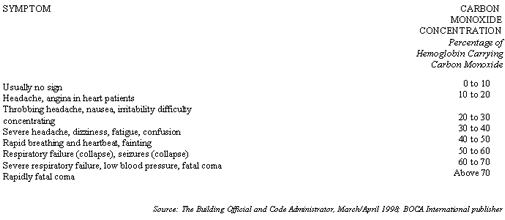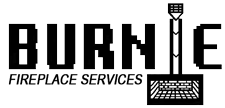Consumer confidence in the convenience and safety of today’s home heating systems is usually well-placed. The oil and gas heating industries have achieved impressive safety records. Nonetheless, according to the U.S. Consumer Product Safety Commission, over 200 people across the nation are known to die each year from carbon monoxide poisoning caused by problems in the venting – out of their homes – of toxic gases produced by their heating systems. Other estimates for total accidental CO poisoning are much higher. The Journal of the American Medical Association , (JAMA Volume 261, No.8, February 24,1989) estimates 1,600 deaths occur yearly.
In addition, around 10,000 cases of carbon monoxide-related injuries are diagnosed each year. Because the symptoms of prolonged, low-level carbon monoxide poisoning mimic the symptoms of common winter ailments (headaches, nausea, dizziness, fatigue, even seasonal depression), many cases are not detected until permanent, subtle damage to the brain, heart and other organs and tissues has occurred. The difficulty of diagnosis also means the numbers of people affected may be even higher.
What Is Carbon Monoxide
By now we all know that carbon monoxide is a very dangerous, colorless, odorless gas, generally associated with your home heating system, but for a little better understanding, let’s take a quick trip back to high school chemistry class.
The gas or oil you burn for home heating are compounds known as hydrocarbons (hydrogen + carbon). In your furnace these hydrocarbons are mixed with oxygen from the air in your home, and burned to produce heat.. When your furnace and chimney are working properly, the gas or oil is burned more or less completely, and the resulting fumes are mainly carbon dioxide (carbon + 2 oxygen atoms) and water vapor.
If your furnace doesn’t get enough oxygen, either because the house is too tight or the chimney isn’t functioning properly, carbon monoxide (carbon +1 oxygen atom) is produced instead. It’s the lack of that one little oxygen atom that causes all the trouble.
What Carbon Monoxide Does to You
Too much carbon monoxide in your blood will kill you. Most of us know to try to avoid this. Less well known is the fact that low-level exposure to this gas also endangers your health.
One of the imperfections of our human bodies is that, given a choice between carbon monoxide and oxygen, the protein hemoglobin in our blood will always latch on to carbon monoxide and ignore the life-giving oxygen. Because of this natural chemical affinity, our bodies – in effect – replace oxygen with carbon monoxide in our bloodstream, causing greater or lesser levels of cell suffocation depending on the intensity and duration of exposure.
The side-effects that can result from this low-level exposure include permanent organ and brain damage. Infants and the elderly are more susceptible than healthy adults, as are those with anemia or heart disease.
The symptoms of low-level carbon monoxide poisoning are so easily mistaken for those of the common cold, flu or exhaustion that proper diagnosis can be delayed. Because of this, be sure to see your physician about persistent, flu-like symptoms, chronic fatigue or generalized depression.Carbon Monoxide symptoms

Why is Carbon Monoxide Poisoning On the Rise?
- Today’s houses are more air tight due to energy conserving measures. Consequently there is less fresh air coming into a home and not as many pathways for stale or polluted air to leave it. When furnaces and boilers are starved of the oxygen needed to burn fuels completely, carbon monoxide is produced. Many newer houses are so airtight that powered exhaust fans in the kitchen and bathroom can overcome the draft in the furnace chimney and literally pull the toxic gases into the living space.
- A The new high-efficiency gas and oil furnaces, when hooked up to existing flues, often do not perform at an optimum level. The differences in performance create conditions that allow combustion byproducts to more easily enter home living spaces.
- A The above conditions join a number of older, on-going problems including damaged or deteriorating flue liners, soot build-up, debris clogging the passageway, and animal or bird nests obstructing chimney flues.
Preventing Problems
In the United States, numerous agencies and organizations now recognize the importance of annual heating system inspection and maintenance in preventing carbon monoxide poisoning. The U.S. Consumer Product Safety Commission, the U.S. Environmental Protection Agency, the National Fire Protection Association, the American Lung Association – are some of the organizations that now encourage the regular maintenance of home heating systems and their chimneys in order to keep “the silent killer” at bay.
A well tuned furnace or boiler, connected to a venting system or flue that is correctly sized, structurally sound, clean and free of blockages, will operate efficiently and produce a warm and comfortable home. Carbon monoxide detectors are now readily available and no home should be without at least two, one near the furnace and one near the sleeping area of the home. Detectors are NOT a substitute for routine maintenance, but can be a lifesaver should problems occur.
Considering the risks involved when gas or oil systems are neglected, and the benefits that accrue when they are properly maintained, we suggest you have your furnace serviced yearly by a qualified technician and your chimneys checked annually by a certified chimney technician and cleaned or repaired as needed.
Why Chimney Maintenance Is Important
When gas and oil burn in vented heating systems, the dangerous fumes that are the by-products of combustion – including carbon monoxide – are released into the chimney through a connector pipe. Funneling these fumes out of the living area is the primary purpose of a chimney. In addition to carrying off toxic gases, chimneys also create the draft (flow of air) that provides the proper air and fuel mixture for efficient operation of the heating appliance. Unfortunately, many chimneys in daily use in homes throughout the country either are improperly sized or have conditions that make them unable to perform their intended function.
GAS. Natural gas is a clean-burning fuel, but todays high-efficiency gas furnaces pose special problems. (see the pages on GAS for a more complete discussion) The fumes they produce are cooler and contain high levels of water vapor, which cause more condensation than older models. Since these vapors also contain chlorides picked up from house-supplied combustion air, the flues are subjected to more corrosive conditions than before and can quickly deteriorate or plug up completely.
OIL. Oil flues need to be cleaned and inspected annually because deposits of soot may build up on the interior walls of the chimney. The amount of soot depends on how well tuned the furnace is and whether the house provides sufficient air for combustion. Excessive soot causes problems ranging from inefficient furnace operation to completely blocked chimneys.
To the extent that problems with either of these heating systems interfere with the flow of toxic gases and particles out of the house, they may also force carbon monoxide into the home. They may cause a one-time, high-level exposure situation or release smaller amounts more regularly over a longer period. These problems should never be ignored.
If You Suspect a Problem
If you ever suspect a carbon monoxide problem, immediately open doors or windows to ventilate the house and get everyone outside for fresh air. Most utility companies will respond to emergency calls and check your house and heating system for the presence of carbon monoxide.
DO NOT reinhabit the house until you are certain there is no longer a problem.
If necessary seek medical attention, treatment is very important. Have the heating system and the chimney checked and serviced by reputable professionals as soon as possible.
